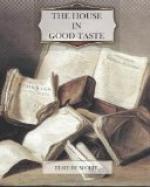It may be argued that the budding collector is as happy with a false object and a fake bauble as if he possessed the real thing, and therefore it were better to leave him to his illusions; that it is his own fault; that it is so much the worse for him if he is deceived. But—you can’t leave the innocent lamb to the slaughter, if you can give him a helping hand. If he must be a collector, let him be first a collector of the many excellent books now published on old furniture, china, rugs, pewter, silver, prints, the things that will come his way. You can’t begin collecting one thing without developing an enthusiasm for the contemporary things. Let him study the museum collections, visit the private collections, consult recognized experts. If he is serious, he will gradually acquire the intuition of knowing the genuine from the false, the worth-while from the worthless, and once he has that knowledge, instinct, call it what you will, he can never be satisfied with imitations.
The collection and association of antiques and reproductions should be determined by the collector’s sense of fitness, it seems to me. Every man should depend on whatever instinct for rightness, for suitability, he may possess. If he finds that he dare not risk his individual opinion, then let him be content with the things he knows to be both beautiful and useful, and leave the subtler decisions for someone else. For instance, there are certain objects that are obviously the better for age, the objects that are softened and refined by a bloom that comes from usage.
An old rug has a softness that a new one cannot imitate. An old copper kettle has an uneven quality that has come from years of use. A new kettle may be quite as useful, but age has given the old one a certain quality that hanging and pounding cannot reproduce. A pewter platter that has been used for generations is dulled and softened to a glow that a new platter cannot rival.
What charm is to a woman, the vague thing called quality is to an object of art. We feel it, though we may not be able to explain it. An old Etruscan jar may be reproduced in form, but it would be silly to attempt the reproduction of the crudenesses that gave the old jar its real beauty. In short, objects that depend on form and fine workmanship for their beauty may be successfully reproduced, but objects that depend on imperfections of workmanship, on the crudeness of primitive fabrics, on the fading of vegetable dyes, on the bloom that age alone can give, should not be imitated. We may introduce a reproduction of a fine bust into our rooms, but an imitation of a Persian tile or a Venetian vase is absurd on the face of it.
The antiques the average American householder is interested in are the old mahogany, oak and walnut things that stand for the oldest period of our own particular history. It is only the wealthy collector who goes abroad and buys masses of old European furniture, real or sham, who is concerned with the merits and demerits of French and Italian furniture. The native problem is the so-called Colonial mahogany that is always alleged to be Chippendale or Heppelwhite, or Sheraton, regardless! There must be thousands of these alleged antiques in New York shops alone!




